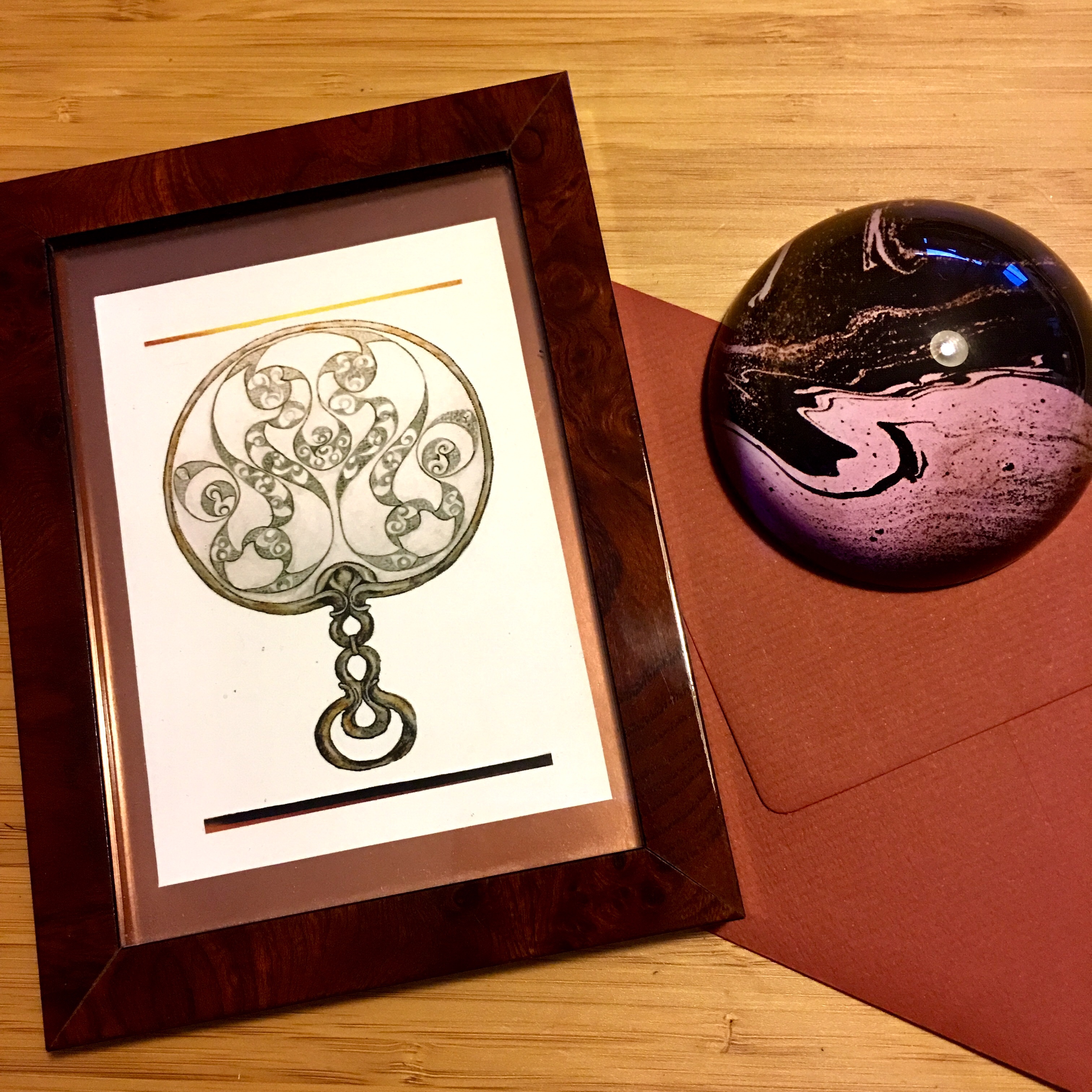
Nuliajuk, the sea goddess of the Nesilik Inuit

The hands of a Netsilik Inuit shaman take tenderly care of Nuliajuk’s tangled hair. After the shaman has healed Nuliajuk’s anger by de-tangling her hair in which sea animals are trapped, fish and sea mammals are set free, and hunters are able to bring home food.. (Graphite drawing on Arches paper).
NULIAJUK, A TIMELESS SEA GODDESS
There is a tender beauty and quality in the ritual a shaman visiting Nuliajuk (also known by the name ‘Sedna’) performs when this fierce goddess is angry. Nuliajuk is the sea-deity on which Netsilik Inuit depend for food and living. When hunters cannot find food, Netsilik Inuit believe that their food is tangled up in Nuliajuk’s hair. A shaman will have to travel to the bottom of the icy cold sea where he or she will find the goddess upset with anger. The animals that have once been her fingers before they morphed into sea mammals are itching! They urgently need to be freed from her long hair.
When the sea is mildly wild, Nuliajuk grows irritated. Her hair becomes tangled up with sea creatures. If only Nuliajuk could de-tangle her hair all would be well again. But she cannot because her father chopped off her fingers. Her fingers dropped next to her to the bottom of the sea where they grew into sea animals. The story of why her fingers got chopped up by her desperate father is another one, which a reader might like to research. For here, the focus lies on a tender and caring task an Inuit shaman has to perform in order to help calming down a frustrated sea goddess.
Nuliajuk has grown so upset with itching and annoying animals, she tries wildly to release them by running her fingers through her hair. To no avail, Nuliajuk can only wildly shake her arms and head, stirring up high waves and as a result the sea becomes wilder and wilder. Hunters cannot find food or bring something edible home and even the sled dogs grow hungry. Animals cannot be hunted, hides cannot get preserved, and the health of the people is declining. It feels like spiralling down: Nuliajuk is so angry, one cannot hunt. And because the wild waves tangle up Nuliajuk’s hair even more, she grows increasingly vexed. Nuliajuk’s powers are thus either life giving when she is calm. But when she is not, people face starvation.
Shamanic Healing
Here a shaman needs to step in. He or she needs to tidy up Nuliajuk’s hair, set free animals after which Inuit are able to regain their hunt. All the shaman needs to do is reach Nuliajuk in a spiritual realm and take care of her hair. Often people relax when their hair is tenderly brushed and for Nuliajuk it is no different. This is the shaman’s task; calming down Nuliajuk, freeing sea mammals, and restoring an equilibrium that is both beneficial for the sea-goddess and for her people.
Can we see Nuliajuk’s mesmerizing hair? Yes, by looking in an ocean or sea. When you sit on a boat and you lean over, look under the surface and you will see movements. These undercurrents are Nuliajuk’s long strands of hair. Isn’t that beautiful? When we are confronted with plastic pollution (tangled up in Nuliajuk’s hair), we feel alarmed which is a good thing because – like in Nuliajuk’s tale -, plastic pollution kills sea animals; discarded fishing nets traps fish and sea mammals like Nuliajuk’s hair.
What does the Inuit shaman look like? Well, just like any other Inuit except that he or she might dress up in a special coat. In 2015, the fashion label KTZ copied a unique shamanic Canadian Arctic garment that dated back to the early 1900s. According to Smithsonian researcher Sima Sahar Zerehi this garment was the ‘most unique garment known to have been created in the Canadian Arctic’. The design was used without the consent of the shaman’s descendants in Nunavut and thus it was pulled from stores. KTZ apologized to the family. But by then it had sparked interest in the origins of the parka and the meaning behind its symbolic designs. Do the large hands on the chest of the garment represent the hands of the shaman that help Nuliajuk with de-tangling her hair, a vital act to restore her mood?
Environmental Goddess
Nuliajuk is a timeless goddess but by now we have traded Nuliajuk’s mood for the Beaufort scale, an empirical measure that relates wind speed to observed sea conditions. When sea animals get trapped in fishing nets, we need people interfering, like shamans calming Nuliajuk. When sea-weeds, which remarkably look like Nuliajuk’s hair, disappear, we find food resources depleting. Taking care of the Great Barrier Reef of Australia by replenishing its coral feels like scientists stepping in for shamans taking care of Nuliajuk’s world.
No matter how we tell a story about our seas and oceans, mythologically or environmentally, we know that the sea takes care of us when we take care of her.
When ancient people of the Island of Man prayed to their Celtic sea god, Manannán (or Manann) to shroud their island in thick mists to protect it from marauding Vikings, people had to pray. Gods like communicating with men, they like offerings and prayers. According to mythological stories they also like to be properly thanked. In the story of Nuliajuk one sees this element of reciprocity: she takes care of her people, they need to help her because of her missing ability to run her fingers through her hair and thus keep it tidy. This reciprocity can be extended to all nature gods, in fact to Nature herself. We have very few shamans left but, wisely, our children are educated on environmental issues at school. Beach cleaning school trips raise lasting awareness of pollution (and contribute to ‘keeping Nuliajuk’s hair well kept).

FOR BUYING:
SEPIA VINTAGE COLOURED SMALL CARDS
This illustration is for sale. It could be used as a book cover or a book illustration. Or a lesson plan illustration. Contact me should you like to use it. The link is here. Its price is negotiable in relation to its copyright.
I also have available smaller cards, prayer or memory cards, with enough white for a personal note or wish.


The QRC (Quick Response Code) can be used to read more on the wonderful sea goddess Nuliajuk. It also can be covered with a nice vintage stamp (ask if you need a vintage stamp via contact form after ordering.

Nuliajuk Card for Meditation Contemplation, Education, Prayer.
This is a smaller art card on strong paper with a monochromatic drawing by Paula Kuitenbrouwer. Nuliajuk receives healing from her shaman; he/she dis-tangles her hair in which sea animals are trapped. Nuliajuk’s mood immediately improves and the sea becomes calm again. Size about 7-10 cm or 3-4 inches. Free shipping.
€5.25
Education
How can we educate our children on Nuliajuk? When trying to buy a book on this goddess, I find only one title: ‘Nuliajuk’ by the explorer Knud Rasmussen, published in 2017 for Grade 3 readers. This is great for young children for learning about the interaction between nature and man by anthropomorphizing nature forces. When these children become high school students, they will remember their mythological education and see stories morphing into environmental science. They might even recognize the small Nuliajuk statute in Leiden’s National Museum of Ethnology (Netherlands). Her small, soapstone statute carries a beautiful historical, environmental, and mythological tale of nature’s power over peoples and over healing reciprocity.
Paula Kuitenbrouwer
Some lesson ideas are:
Explain the role of the shaman and compare him/her to priests, doctors and environmental activists. Look up the four animals that are trapped in Nuliajuk’s hair. Explain why they are mammals and not fish. Explain why Nuliajuk has become an environmental goddess who needs our help; explain on a larger scale taking care of our environment. Explain why we need seas and oceans for food and future food (seaweeds and algae). Compare Nuliajuk’s hair with discarded fishing nets. Explain why we need nature and why nature needs our care.
Paula Kuitenbrouwer
Paula Kuitenbrouwer holds an MA degree in Philosophy (UvA) and is the owner of mindfuldrawing.com. Her pen and pencils are always fighting for her attention nevertheless they are best friends; Paula likes her art to be brainy and her essays to be artistic.
Paula’s shop is at Etsy & her portfolio is at Instagram @mindfuldrawing





























